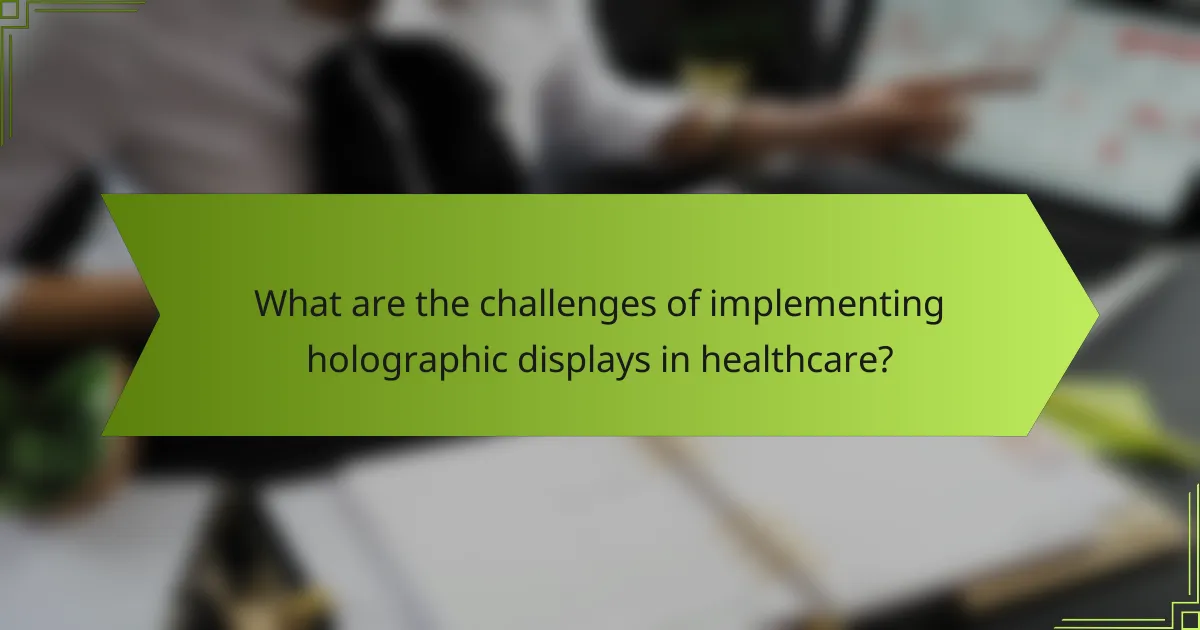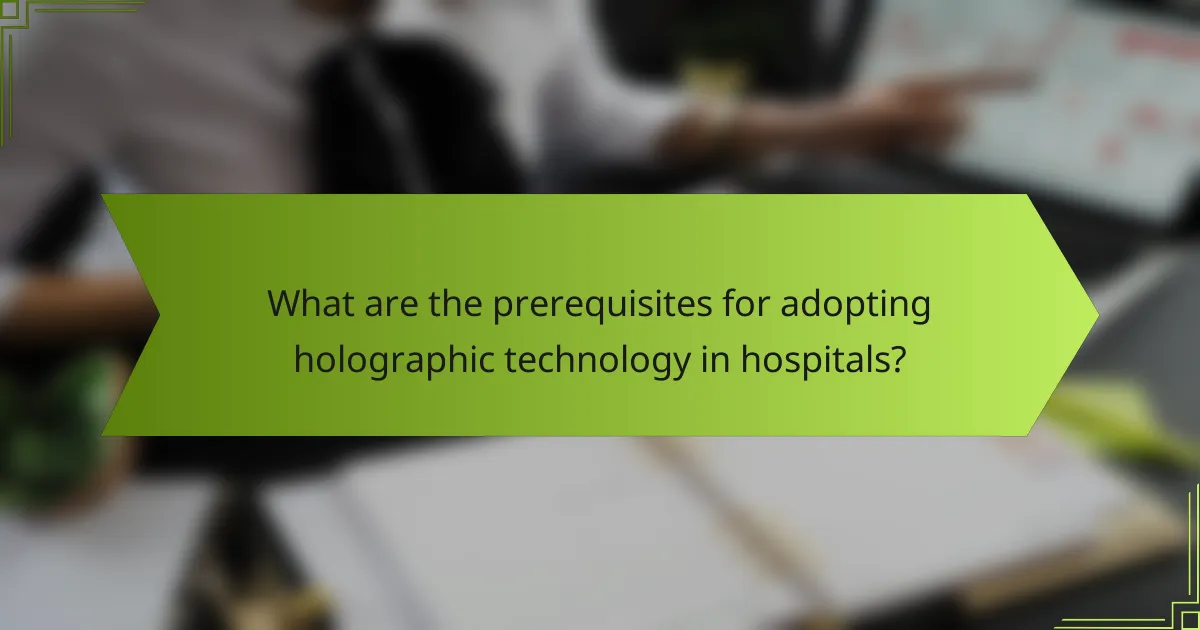Holographic displays are revolutionizing the field of medicine by offering immersive training experiences that significantly improve learning outcomes for healthcare professionals. By enabling the visualization of complex anatomical structures and procedures in three dimensions, these technologies not only enhance skill acquisition but also foster better communication and understanding between medical practitioners and patients, ultimately leading to improved patient care.

How are holographic displays used in medical training?
Holographic displays are transforming medical training by providing immersive, interactive experiences that enhance learning and retention. These advanced visual technologies allow medical professionals to practice complex procedures and visualize anatomical structures in three dimensions, improving both skill acquisition and patient care.
Enhanced surgical simulations
Holographic displays enable realistic surgical simulations that mimic actual operating conditions. Trainees can practice procedures on virtual patients, allowing them to make mistakes and learn without the risk associated with real-life surgeries. This hands-on experience is crucial for developing the muscle memory and decision-making skills needed in high-pressure environments.
For example, a surgical resident can rehearse a laparoscopic procedure using a holographic model, gaining familiarity with the instruments and techniques before entering the operating room. This method can significantly reduce the learning curve and enhance overall surgical proficiency.
Interactive anatomy visualization
Holographic displays facilitate interactive anatomy visualization, allowing students to explore complex bodily systems in a three-dimensional space. This immersive approach helps learners understand spatial relationships and anatomical variations more effectively than traditional 2D images or models.
For instance, medical students can manipulate holograms of organs to view them from different angles, enhancing their comprehension of human anatomy. Such interactive learning experiences can lead to better retention of information and improved diagnostic skills.
Remote collaboration for training
Holographic displays support remote collaboration, enabling medical professionals to train together regardless of their physical location. This technology allows experts to guide trainees in real-time, providing feedback and instruction as they navigate complex procedures or anatomical studies.
For example, a surgeon in one country can assist a trainee in another by sharing a holographic view of a surgical procedure. This capability not only enhances training opportunities but also fosters a global exchange of knowledge and techniques in the medical field.

What benefits do holographic displays offer in patient care?
Holographic displays enhance patient care by providing immersive visualizations that improve understanding and communication. These technologies allow patients to visualize their medical conditions and treatment options more clearly, leading to better-informed decisions.
Improved patient understanding of conditions
Holographic displays can transform complex medical information into 3D visualizations, making it easier for patients to grasp their health conditions. For instance, a hologram of a tumor can show its size and location relative to surrounding organs, which aids in comprehension.
This enhanced understanding can lead to increased patient engagement in their own care. When patients visualize their conditions, they are more likely to ask questions and participate actively in discussions about treatment options.
Enhanced communication between doctors and patients
Using holographic displays fosters clearer communication between healthcare providers and patients. Doctors can present treatment plans and surgical procedures in a more interactive way, allowing patients to visualize what to expect.
This method reduces misunderstandings and helps build trust. Patients who can see a 3D model of their treatment are often more comfortable and confident in their healthcare decisions.
Real-time data visualization during consultations
Holographic displays enable real-time visualization of patient data during consultations, which can significantly enhance the decision-making process. Doctors can overlay patient history, lab results, and imaging data onto a holographic model, providing a comprehensive view of the patient’s health.
This capability allows for immediate adjustments to treatment plans based on the most current data. It also helps in educating patients about their health in the moment, making consultations more productive and informative.

What are the leading companies in holographic display technology?
The leading companies in holographic display technology include Microsoft, Magic Leap, and Holoxica. These firms are at the forefront of developing innovative solutions that enhance medical training and patient care through immersive visual experiences.
Microsoft HoloLens
Microsoft HoloLens is a mixed-reality headset that integrates holographic displays with real-world environments. It is widely used in medical training, allowing students and professionals to visualize complex anatomical structures and procedures in 3D.
HoloLens enables interactive simulations, where users can manipulate holograms to better understand surgical techniques or patient anatomy. This hands-on approach enhances learning retention and prepares medical professionals for real-life scenarios.
Magic Leap
Magic Leap focuses on spatial computing and offers a headset that projects digital content into the user’s environment. In healthcare, it provides tools for visualization and collaboration, allowing teams to work together on patient cases from different locations.
Its technology supports applications such as remote consultations and interactive anatomy lessons, making it easier for medical professionals to share insights and improve patient outcomes. The immersive experience fosters a deeper understanding of complex medical concepts.
Holoxica
Holoxica specializes in holographic displays that create 3D visualizations without the need for glasses. This technology is particularly beneficial in medical training, where clear and detailed representations of organs and systems are crucial.
By using Holoxica’s solutions, medical students can view realistic holograms of human anatomy, enhancing their ability to learn and retain information. The technology also facilitates better communication between healthcare providers and patients by providing clear visual explanations of diagnoses and treatment options.

How do holographic displays compare to traditional training methods?
Holographic displays offer a more immersive and interactive experience compared to traditional training methods, enhancing both understanding and skill acquisition. They allow medical trainees to visualize complex anatomical structures and procedures in three dimensions, which can significantly improve learning outcomes.
Higher engagement and retention rates
Holographic displays can lead to higher engagement and retention rates among medical trainees. By providing a dynamic and interactive learning environment, these displays capture attention more effectively than static images or lectures. Studies suggest that learners using holographic technology may retain information up to 30% better than those relying on conventional methods.
For instance, when practicing surgical techniques, trainees can manipulate 3D holograms of organs, which fosters a deeper understanding of spatial relationships and procedural steps. This hands-on approach not only keeps learners engaged but also enhances their ability to recall information during actual procedures.
Cost-effectiveness in long-term training
While the initial investment in holographic technology may be significant, it can prove cost-effective in the long run. Traditional training often requires repeated use of cadavers or physical models, which can be expensive and logistically challenging. Holographic displays eliminate these costs by providing a reusable and versatile training tool.
Moreover, as technology advances, the costs associated with holographic displays are expected to decrease, making them more accessible for medical institutions. By integrating holographic training into their programs, institutions can reduce expenses related to materials and maintenance while improving training efficiency.

What are the challenges of implementing holographic displays in healthcare?
Implementing holographic displays in healthcare faces several challenges, including high costs, the need for specialized training, and integration with existing systems. These factors can hinder the widespread adoption of this technology in medical training and patient care.
High initial investment costs
The initial investment for holographic display technology can be substantial, often reaching tens of thousands of dollars. This includes not only the hardware but also software licenses and maintenance fees. Healthcare facilities must weigh these costs against potential long-term benefits, such as improved training outcomes and enhanced patient engagement.
Budget constraints can limit the ability of smaller practices or hospitals to adopt this technology. To mitigate costs, some organizations may explore partnerships or funding opportunities that support innovative medical technologies.
Need for specialized training for staff
Staff members must undergo specialized training to effectively utilize holographic displays, which can be time-consuming and resource-intensive. Training programs should cover both the technical aspects of operating the displays and the best practices for integrating them into patient care and training scenarios.
Healthcare providers may consider developing a phased training approach, allowing staff to gradually adapt to the technology while minimizing disruptions to daily operations. Ongoing support and refresher courses can further enhance staff proficiency.
Integration with existing systems
Integrating holographic displays with existing healthcare systems can pose significant challenges, particularly regarding data compatibility and workflow adjustments. Ensuring that holographic technology seamlessly interacts with electronic health records (EHR) and other digital tools is crucial for maximizing its effectiveness.
Healthcare organizations should conduct thorough assessments of their current systems before implementation. This may involve consulting with IT specialists to identify potential integration issues and developing a clear plan for addressing them, which can help streamline the transition to holographic technology.

What are the prerequisites for adopting holographic technology in hospitals?
Adopting holographic technology in hospitals requires careful consideration of infrastructure, staff training, and regulatory compliance. These prerequisites ensure that the technology can be effectively integrated into medical training and patient care processes.
Infrastructure readiness
Hospitals must evaluate their existing infrastructure to support holographic displays, which often require advanced computing power and high-speed internet connectivity. Upgrading network systems and ensuring compatibility with current medical devices are essential steps.
Additionally, physical space must be allocated for holographic installations, including areas for training and patient interaction. Hospitals should consider the layout and accessibility of these spaces to maximize the technology’s benefits.
Staff training programs
Effective implementation of holographic technology hinges on comprehensive staff training programs. Medical professionals need to understand how to operate holographic displays and integrate them into their workflows, which may involve hands-on training sessions and workshops.
Training should also cover the interpretation of holographic data and its application in clinical scenarios. Hospitals may benefit from partnering with technology providers to develop tailored training modules that address specific needs and challenges within their teams.
